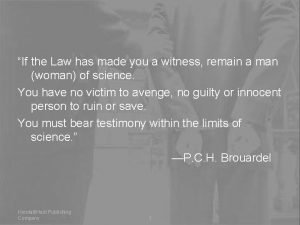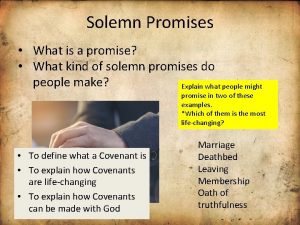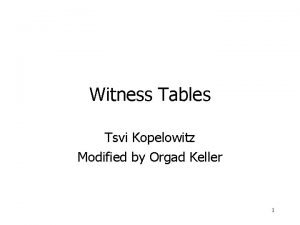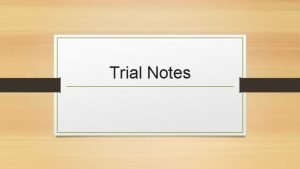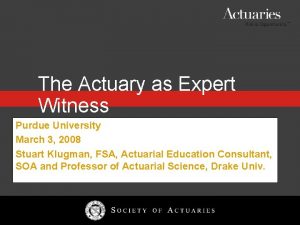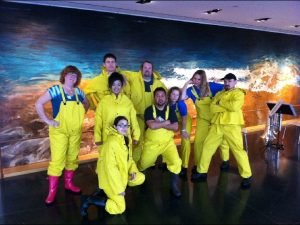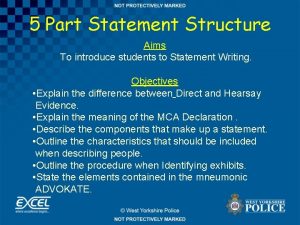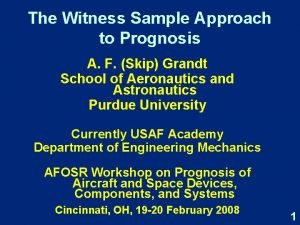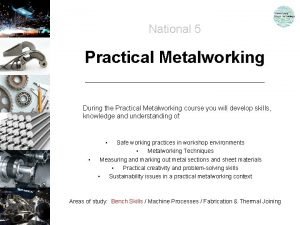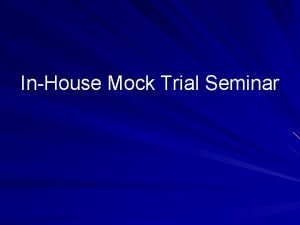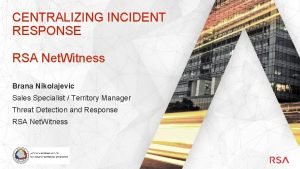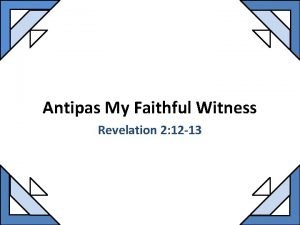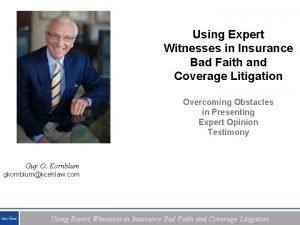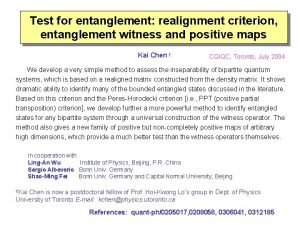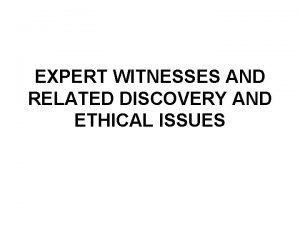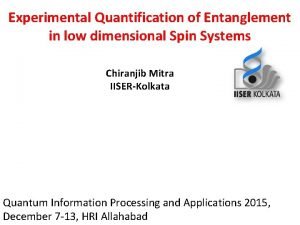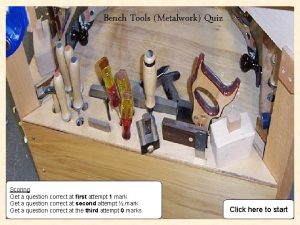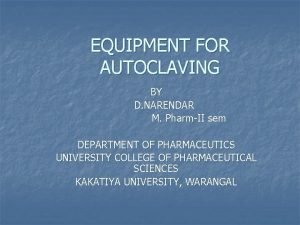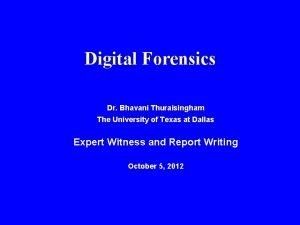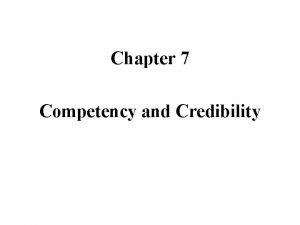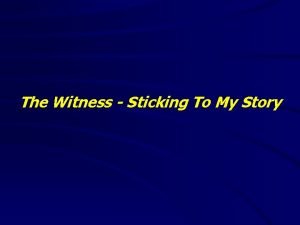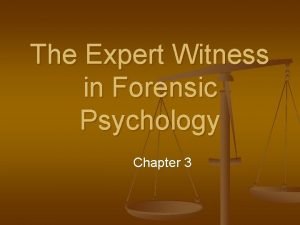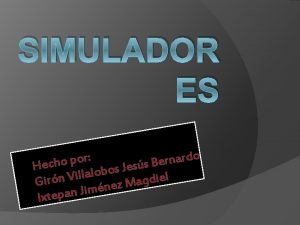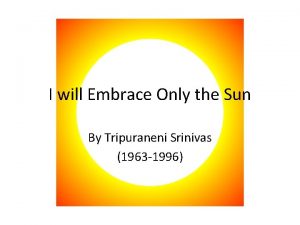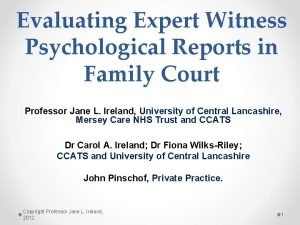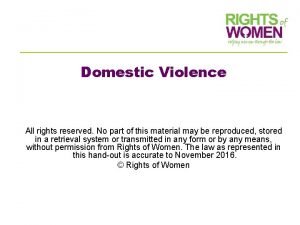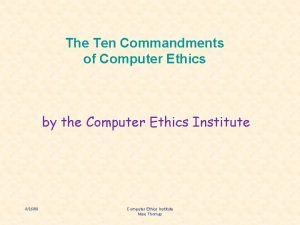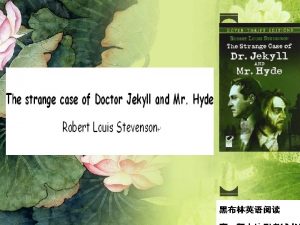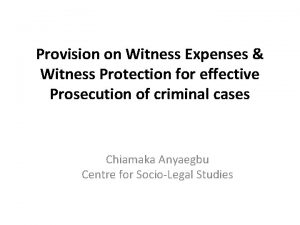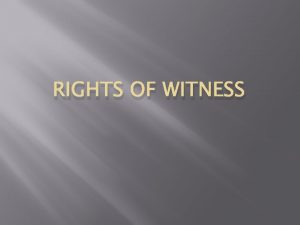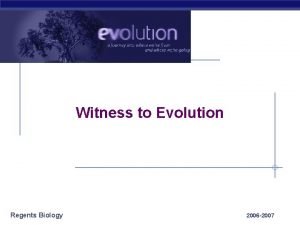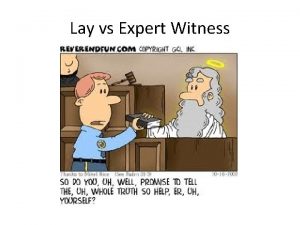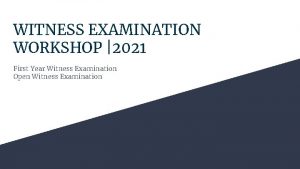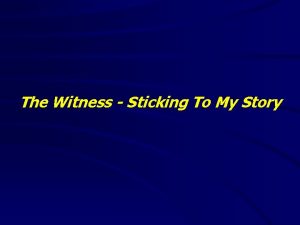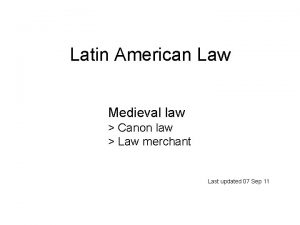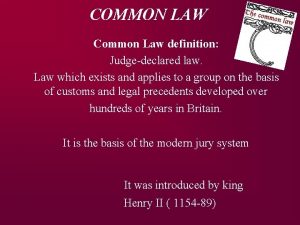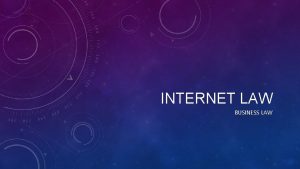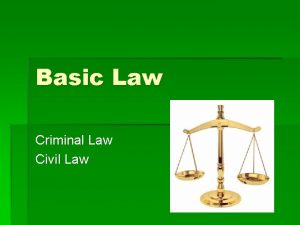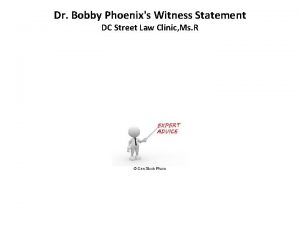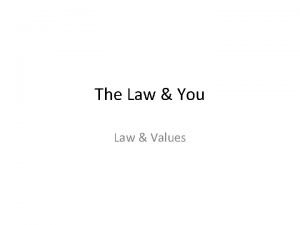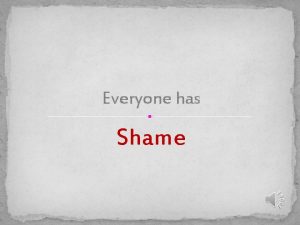If the Law has made you a witness



















































- Slides: 51

“If the Law has made you a witness, remain a man (woman) of science. You have no victim to avenge, no guilty or innocent person to ruin or save. You must bear testimony within the limits of science. ” —P. C. H. Brouardel Kendall/Hunt Publishing Company 1

LEGAL SYSTEMS Forensic Science

Investigating the Scene � � After securing the scene with 18 officers, the police force began to survey the area and take pictures of the general surroundings. Investigators went to contact O. J. Simpson, Nicole Simpson’s ex-husband, at his house 2 miles away to ask him to collect his children. There, they immediately noticed blood on the driver’s door of Simpson’s Bronco. Fearing that Simpson had also become victim to murder because no one answering the phone, investigators climbed over the stone wall and unlocked the door to the property. 3

They came across a blood-stained right-handed glove on the walkway that looked similar to the bloody lefthanded glove found at the crime scene, and blood drops near and in two cars, a Saab and a Bentley. Further investigation of the Bronco nearby presented a multitude of blood stains around and inside the car. Blood lead from the car to the front door of the house. Soon a photographer was brought on scene to take pictures, and shortly after the blood spots and glove were confiscated without a warrant under the belief that the evidence was in plain view. 4

OJ Simpson Evidence Errors � "There were two identical containers sitting side by side, one marked 'bile' and one marked 'urine, ' and the wrong stuff got put in the wrong bottle. The defense people know all about this because they had a representative in the office. We caught it in plenty of time. " 5

OJ Simpson Evidence Errors � A deputy coroner conceded that Mrs. Simpson's stomach contents had been discarded and that the knife wounds could have been more carefully examined. He also acknowledged that medical examiners had waited an unusually long time -- 10 hours -- to examine the bodies. 6

What went wrong? � 1 st on the scene, police found evidence of blood & entered the Simpson home without a search warrant, an action permissible b/c the situation was an emergency. � HOWEVER, the police collected a pair of blood -stained gloves during their search. � Collection of evidence without proper warrants became the key argument used by Simpson’s legal team & ultimately led to his acquittal.

What was learned? � If forensic evidence is to be admissible in court, the highest professional standards must be used at the crime scene! � He was found liable for their deaths in civil court, but has yet to pay the $33. 5 million judgment.

Civil vs. Criminal Law CIVIL LAW CRIMINAL LAW filed by a private party. o a corporation o an individual filed by the government Penalty: a guilty defendant is punished by Penalty: a guilty defendant o incarceration (in jail/prison) pays the plaintiff for losses o fine paid to the gov’t caused by their actions. o execution (death penalty) o no incarceration Crimes are divided into 2 classes: o misdemeanors - < 1 year incarceration o felonies - 1+ year sentence

Our Rights and Their Effect on Forensic Evidence � Understanding the rights of United States citizens under the law (Bill of Rights) is vital Bill of Rights when collecting, analyzing, and presenting evidence in the legal system 10

Laws that Pertain to the U. S. Criminal Justice System § § § § The U. S. Constitution Statutory Law Common Law or Case Law Civil Law Criminal Law Equity Law Administrative Law Kendall/Hunt Publishing Company 11

The Bill of Rights Gives individuals the right: § § § § § To be presumed innocent until proven guilty Not to be searched unreasonably Not to be arrested without probable cause Against unreasonable seizure of personal property Against self-incrimination To fair questioning by police To protection from physical harm throughout the justice process To an attorney To trial by jury To know any charges against oneself Kendall/Hunt Publishing Company § § § § § 12 To cross-examine prosecution witnesses To speak and present witnesses Not to be tried again for the same crime Against cruel and unusual punishment To due process To a speedy trial Against excessive bail Against excessive fines To be treated the same as others, regardless of race, gender, religious preference, country of origin, and other personal attributes

Miranda v Arizona § In 1963, Ernesto Miranda, a 23 year old mentally disturbed man, was accused of kidnapping and raping an 18 -year-old woman in Phoenix, Arizona. He was brought in for questioning, and confessed to the crime. He was not told that he did not have to speak or that he could have a lawyer present. At trial, Miranda's lawyer tried to get the confession thrown out, but the motion was denied. The case went to the Supreme Court in 1966. The Court ruled that the statements made to the police could not be used as evidence, since Mr. Miranda had not been advised of his rights. Kendall/Hunt Publishing Company 13

Miranda Rights The following is a minimal Miranda warning: § You have the right to remain silent. Anything you say can and will be used against you in a court of law. You have the right to speak to an attorney, and to have an attorney present during any questioning. If you cannot afford a lawyer, one will be provided for you at the government’s expense. Kendall/Hunt Publishing Company 14

Evidence Collection – The Fourth Amendment 4 th Right of Search and Seizure Regulated �“The right of the people to be secure in their persons, houses, papers, and effects, against unreasonable searches and seizures, shall not be violated, and no warrants shall issue, but upon probable cause, supported by oath or affirmation, and particularly describing the place to be searched, and the persons or things to be seized. ” 15

Federal Rules of Evidence In order for evidence to be admissible, it must be: § § Probative—actually prove something Material—address an issue that is relevant to the particular crime Kendall/Hunt Publishing Company 16

Admissibility of Evidence 1993 Daubert v. Dow 1923 Frye v. United States ý Scientific evidence is allowed into the courtroom if it is generally accepted by the relevant scientific community. The Frye standard does not offer any guidance on reliability. The evidence is presented in the trial and the jury decides if it can be used. Kendall/Hunt Publishing Company 17 Admissibility is determined by: ý Whether theory or technique can be tested ý Whether the science has been offered for peer review ý Whether the rate of error is acceptable ý Whether the method at issue enjoys widespread acceptance. ý Whether the opinion is relevant to the issue The judge decides if the evidence can be entered into the trial.

Evidence Collection – The Fourth Amendment (continued) Unlawful Search and Seizure �When the court says an individual’s rights were violated, any evidence derived from the search and seizure will be kept out of the criminal case, if the case is against the case person whose rights were violated �It is very important that evidence is collected lawfully, without an invasion of privacy or with lawfully a search warrant, so it will not be ruled inadmissible in court 18

Evidence Collection – The Fourth Amendment (continued) • Searching – Was There an Invasion of Searching Privacy? The court will ask two things (if either of these answers is no, then any evidence collected can be admissible in court) – Did the owner of the home or property that was investigated or searched expect a “degree of privacy”? – Was this expectation of privacy reasonable and legitimate? 19

Evidence Collection – The Fourth Amendment (continued) Search Warrant – a judicial order that Search Warrant authorizes the law enforcement agencies to conduct a search of a location/person and to seize any evidence of a criminal offense. To issue a search warrant police have to show the judge that �Probable cause exists that a crime has occurred �Evidence or contraband linked to the crime will probably be found on a certain location on the property or person at issue 20

Evidence Collection – The Fourth Amendment (continued) Search Warrant Not Needed Not � Consent is given for the search (no warrant is Consent needed, even in the future, once consent is given) � Emergency – someone is in danger, or there might be Emergency destruction of evidence � After an arrest – an officer can search the person and After an arrest immediate surroundings � Plain view – if the police are there legally and Plain view evidence is in plain view � Reasonable suspicion – if police believe they will find Reasonable suspicion a weapon or drugs on a person or in a car, they can legally search 21

Regulations for the Prosecution th Fifth Amendment 5 • “No person shall be held to answer for a capital, or otherwise infamous crime, unless on an indictment of a Grand Jury, except in cases arising in the land or naval forces, or in the militia, when in actual service in time of war or public danger; nor shall any person be subject for the same offense to be twice put in jeopardy of life or limb; nor shall be compelled in any criminal case to be a witness against himself, nor be deprived of life, liberty, or property, without due process of law; nor shall private property be taken for public use without just compensation. ” 22

Regulations for the Prosecution – Fifth Amendment (continued) • Difficult/Publicized/Capitol Cases In many states, a grand jury (16 – 24 citizens) meets grand jury to decide if there is enough evidence before a citizen can even be indicted for a crime – The grand jury is an “arm” of the prosecutor office, the defense does not even present at a grand jury – � Plea Bargaining � up to 90% of all cases are plea bargained and never go to trial (Deslich, 2006) 23

Regulations for the Prosecution – Fifth Amendment (continued) • Double Jeopardy A person cannot be put on trial again for the same crime – It is imperative that every bit of evidence be found in the case before it is brought to trial – � Due Process – everyone is treated the same, Due Process gets trial by jury 24

Regulations for the Prosecution – Fifth Amendment (continued) • “Pleading the 5 th” You do not have to be at witness against yourself • The prosecution has to prove your guilt • You have the right to remain silent • 25

Trial Policies – Sixth Amendment • 6 th “In all criminal prosecutions, the accused shall enjoy the right to a speedy and public trial, by an impartial jury of the state and district wherein the crime shall have been committed, which district shall have been previously ascertained by law, and to be informed of the nature and cause of the accusation; to be confronted with the witnesses against him; to have compulsory process for obtaining witnesses in his favor, and to have the assistance of counsel for his defense. ” 26

Trial Policies – Sixth Amendment (continued) � Speedy Trial � Depends on state statute, but generally 90 – 120 days � The following slow the process: The defendant is out on bail Motions Illness Lack of attorney(s) � The defendant can ask for a speedier trial; for law enforcement this is mixed news Speedy trial rules make it imperative to find all of the evidence as soon as possible Delays might be beneficial to law enforcement because they lengthen the evidence collection and analysis time period 27

Trial Policies – Sixth Amendment (continued) • • Witnesses – any witness for the defense or the Witnesses prosecution can be subpoenaed to appear in court Informed of Charge Once arrested, a defendant has 72 hours to be arraigned, told what he is charged with, and offer his plea – The more evidence collected before the arrest, the more specific the arraignment will be. (It also informs bail amount. ) – 28

Trial Policies – Sixth Amendment (continued) � Defense Council � A defendant has the right to an attorney If they can’t afford one, the court must provide one A defense attorney must know every bit of the prosecutor’s evidence in the case to prepare The defense attorney’s job is to get the defendant freed —any and all evidence and evidence procedures can be questioned; this includes collection, handling, delivery, analysis, testimony, and documentation 29

Trial Policies – Seventh Amendment � 7 th “In suits at common law, where the value in controversy shall exceed twenty dollars, the right of trial by jury shall be preserved, and no fact tried by a jury shall be otherwise reexamined in any court of the United States, than according to the rules of the common law. ” 30

Trial Policies – Seventh Amendment (continued) • • Civil vs. criminal matters Impartial Trial by Jury • • Jury of the individual’s peers is the standard United States Court • all courts used for trials should be controlled by the United States government; furthermore, all verdicts handed down by these courts are final (unless appealed to a higher court) 31

The Evidence in Court • • How evidence is received in a court of law is extremely important to a crime scene professional Because of the Constitution’s view of “innocent until proven guilty” and the rights of the accused, it is crucial that those in law enforcement understand the types of evidence, how it is perceived in court, how to testify to its significance, and the importance of proper evidence collection and handling 32

Power of the Evidence in Court � Probative Value � Higher value if the evidence can prove something in court � The lower the probability of an event, the higher the probative value � Probability – the frequency of the occurrence of Probability an event � Defines the odds that a certain event will occur (or the matching of a certain pieces of evidence) � Normally found by multiplying the odds 33

Types of Evidence in Court � Direct Evidence – evidence that establishes a Direct Evidence fact � Eyewitness testimony or victim’s testimony � Confessions � Audio or visual recording of the act or crime 34

Types of Evidence in Court � Indirect Evidence � Circumstantial evidence Requires that a judge and/or jury make inferences about what transpired at the scene of a crime Physical evidence is nearly always circumstantial, so evidence analyzed forensically is mostly indirect evidence � Inference example: fingerprints or hairs found at the scene are consistent with that of a perpetrator; jurors may infer that the print or hair belongs to the defendant, linking him to the scene. 35

Influence of Direct vs. Indirect Evidence • • Indirect circumstantial evidence is more objective, while direct evidence is subjective In general, direct evidence is not considered to be as reliable as circumstantial evidence Eyewitnesses can be deficient when identifying perpetrators or remembering certain events – Flawed questioning techniques can lead to erroneous testimony and confessions – The age of the eyewitness and the passing of time since the event can also lead to faulty testimony – “Direct” does NOT mean better! 36

Influence of Direct vs. Indirect Evidence (continued) � Court research comparing the impact of the type of evidence differs in its results � Some research says direct (eyewitness) evidence has a stronger impact on the jury � At other times, physical evidence was considered more valid by jurors � Some studies suggest that having both types of both evidence is no more compelling than having strong evidence of only one type 37

Influence of Direct vs. Indirect Evidence (continued) � The forensic scientist should � Always be aware of the persuasive nature of eyewitness testimony � In no way allow that to interfere with the scientific method when analyzing physical evidence or developing a hypothesis when investigating a crime � The direct evidence of a police officer’s testimony (concerning the source of evidence, documentation, and chain of custody) corroborates and strengthens the probative value of physical evidence � Be unbiased! 38

Categories of Physical Evidence � Individual Evidence – can be linked to a unique, Individual Evidence specific source (individual) with a very high degree of probability � Examples Matching ridge characteristics of fingerprints Matching striations of two different bullets from the same gun The irregular edges of a broken object (paper, glass, etc. ) that fit together like a jigsaw puzzle (this type of evidence is not found very often) DNA 39

Categories of Physical Evidence (continued) � Class Evidence – evidence that can only be Class Evidence associated with a group and never a single source � Examples: a paint chip, blood of a certain ABO type � The way to increase the probative value of class evidence is to find as many different types of class evidence as possible to link the suspect to the crime Multiple pieces of class evidence can be convincing 40

Evidence Admissibility In a Court of Law � Not only will the court compare the Bill of Rights to how evidence was collected, but there are court precedents that determine the admissibility of scientific results and how those results are explained in court � Frye v. United States, 1923 – The Frye Standard: the , 1923 – The Frye Standard: questioned scientific procedure or principles must be “generally accepted” by a majority of the scientific generally accepted community 41

Evidence Admissibility In a Court of Law (continued) � Daubert v. Merrell Dow Pharmaceuticals, 1993 Verdict replaced the Frye Standard Areas of inquiry by the judge acting as the gatekeeper �Can the scientific technique or theory be tested? �Has the technique or theory been subjected to peer review? �What is the technique’s potential rate of error? �Are there standards to control the technique’s operation, and are these maintained? �Has the technique or theory attracted widespread acceptance within scientific community? 42

Federal Rules of Evidence Expert Testimony • Expert Testimony – hearsay from a witness is normally not allowed in court, except in the case of an expert witness • Expert Witness – a witness “qualified as an expert by knowledge, skill, experience, training, or education” (Deslich, 2006) may offer expert testimony on a scientific matter if – The testimony is based upon sufficient facts – The testimony is the product of reliable principles and methods – The witness has applied the principles and methods reliably to the facts of the case 43

Court Significance of Procedures in Evidence Collection and Analysis • Every step of the process for collecting, handling, analyzing, transporting, and storing evidence is scrutinized in a court of law. So there are guidelines that must be followed forensic evidence and its results to be admissible in court A systemic search for all evidence must be conducted – All evidence must be collected, including large items and trace evidence that must be vacuumed – Must maintain Chain of Custody – 44

Court Significance of Procedures in Evidence Collection and Analysis (continued) � Comparison-type evidence should be collected when possible � Reference Samples – should be collected for comparison Examples �Paint chip from a hit-and-run suspect �Blood and hair samples from the victim, suspects, all family members (and pets), and crime scene investigators �These reference samples are then available for comparison, elimination, and matching to those unknown specimens collected at the crime scene 45

Court Significance of Procedures in Evidence Collection and Analysis (continued) • Proper packaging and separation of evidence is crucial Cross-contamination (or contact) with other persons or evidence is to be avoided at all cost – Proper tools for collection and storage should always be used (envelopes, vials, bags, etc. ) – Always follow strict packaging guidelines for all evidence, and never package any two pieces of evidence together – Decontamination of personnel between crime scenes is important – 46

Court Significance of Procedures in Evidence Collection and Analysis (continued) � Chain of Custody – the witnessed, written record of all individuals who had the evidence in their possession from the crime scene to the courtroom; and when, where, and for what purpose this transfer of evidence occurred The item of evidence itself should be identified; the location, time, and person collecting should also be recorded � The evidence container should also be marked for identification, showing the collector’s initials, the location of evidence, and the date it was received by the collector � If the evidence is turned over to another individual for any reason (care or delivery), this transfer must be recorded in the notes and/or forms � 47

Court Significance of Procedures in Evidence Collection and Analysis (continued) • Chain of Custody (continued) Any samples of the evidence taken for testing or any changes in the evidence should be documented immediately – Every individual who possesses the evidence must maintain a written record of its acquisition/disposition and may be called to testify in court; this includes individuals from the collection, to delivery, to the laboratory analysis, and then into the courtroom with the prosecuting attorney – 48

Court Significance of Procedures in Evidence Collection and Analysis (continued) • Chain of Custody (continued) To avoid confusion, the number of individuals involved in the chain of custody, should be kept to a minimum – The chain of custody record is often kept as a form on the container or envelope of the evidence – Failure to substantiate the evidence’s chain of custody may lead to serious questions regarding the authenticity and integrity of the evidence – 49

Resources � � � Saferstein, Richard. Forensic Science: An Introduction. New Jersey: Pearson Prentice Hall, 2008. Bertino, Anthony J. Forensic Science: Fundamentals & Investigations. Mason, OH: South-Western Cengage Learning, 2009. Deslich, Barbara; Funkhouse, John. Forensic Science for High School Dubuque, Iowa: Kendall/Hunt Publishing Company, 2006. "Simpson Case Has Errors, Coroner Says. " New York Times 21 July 1994, A 19 sec. New York Times Company. Web. 31 July 2009. http: //www. nytimes. com/1994/07/21/us/simpson-case-haserrors-coroner-says. html Jones, Thomas. “Analysis of the O. J. Simpson Murder Trial. ” 2008. Tru. TV. July 31, 2009. http: //www. trutv. com/library/crime/notorious_murders/famous/simpson/ind ex_1. html Linder, Douglas. “Famous American Trials: The O. J. Simpson Trial. ” 2006. University of Missouri-Kansas City School of Law. 31 July 2009. http: //www. law. umkc. edu/faculty/projects/ftrials/Simpson/simpson. ht m 50

Resources (continued) � � � � “The State of California vs. Orenthal James Simpson” [ transcript of testimony of William Bodziak]. 19 June 1995. University of Missouri-Kansas City School of Law. 31 July 2009. http: //www. law. umkc. edu/faculty/projects/ftrials/Simpson/Bodziak. html “The State of California vs. Orenthal James Simpson” [transcript of testimony of Henry Lee]. 19 June 1995. University of Missouri-Kansas City School of Law. 31 July 2009. http: //www. law. umkc. edu/faculty/projects/ftrials/Simpson/leetest. html Thompson, William. “Proving the Case: The Science of DNA Evidence: DNA Evidence in the OJ Simpson Trial. ” 30 December 2008. Ramapo College of New Jersey. 31 July 2009, http: //phobos. ramapo. edu/~jweiss/laws 131/unit 3/simpson. htm http: //haberdasher. hubpages. com/hub/OJ-Simpson-An-Analysis-of-the-Crimeand-Forensic-Techniques http: //articles. latimes. com/1995 -04 -14/news/mn-54675_1_evidence-collection http: //www. pbs. org/wgbh/pages/frontline/oj/themes/prosecution. html http: //www. crimemuseum. org/oj_acquittal_trial_suit 51
 If the law has made you a witness
If the law has made you a witness Newton's first law and second law and third law
Newton's first law and second law and third law Newton's first law
Newton's first law Boyles law
Boyles law Avogadro's law constant
Avogadro's law constant If i could only teach you one thing
If i could only teach you one thing Solemn promises
Solemn promises Witness tables
Witness tables Karen hesse witness
Karen hesse witness Had tom ever come inside the ewell’s fence before?
Had tom ever come inside the ewell’s fence before? Actuary expert witness
Actuary expert witness Steven izenour
Steven izenour Hand written will
Hand written will Unland: irreversible witness
Unland: irreversible witness Sexual assault expert witness
Sexual assault expert witness Addiction psychiatry expert witness
Addiction psychiatry expert witness How to write a five part statement
How to write a five part statement The witness crack
The witness crack Witness marks metalwork
Witness marks metalwork Prior inconsistent statements
Prior inconsistent statements Rsa secops
Rsa secops Antipas my faithful witness
Antipas my faithful witness Witness god's wonders
Witness god's wonders For my lord
For my lord Insurance adjustors expert witness
Insurance adjustors expert witness Entanglement witness
Entanglement witness Java lawsuit
Java lawsuit Chiranjib mitra news
Chiranjib mitra news Witness marks metalwork
Witness marks metalwork Performance qualification protocol
Performance qualification protocol Example of an expert witness digital forensics report
Example of an expert witness digital forensics report Witness competency
Witness competency The witness short story
The witness short story Expert forensic psychology witness
Expert forensic psychology witness Witness simulador
Witness simulador Witness intimidation by prosecutor
Witness intimidation by prosecutor Do not bear false witness
Do not bear false witness Letters from rifka summary
Letters from rifka summary I will embrace only the sun central idea
I will embrace only the sun central idea Commonly agreed upon
Commonly agreed upon Psychologist report for family court
Psychologist report for family court How to write a witness statement for court
How to write a witness statement for court Thou shalt not use a computer to bear false witness
Thou shalt not use a computer to bear false witness Witness protection program philippines
Witness protection program philippines Why has lanyon and jekyll’s friendship cooled
Why has lanyon and jekyll’s friendship cooled Hát kết hợp bộ gõ cơ thể
Hát kết hợp bộ gõ cơ thể Slidetodoc
Slidetodoc Bổ thể
Bổ thể Tỉ lệ cơ thể trẻ em
Tỉ lệ cơ thể trẻ em Voi kéo gỗ như thế nào
Voi kéo gỗ như thế nào Glasgow thang điểm
Glasgow thang điểm Alleluia hat len nguoi oi
Alleluia hat len nguoi oi
